Risk Assessment for AB-99 Program at Peerasit Patanakul
VerifiedAdded on 2021/06/22
|10
|2337
|123
Report
AI Summary
This report presents a program risk assessment for the AB-99 program at Peerasit Patanakul, a multinational aerospace manufacturer. The assessment covers the integration of 99 multi-mission helicopters. The report details the risk management system, policy, and procedures, including risk identification, assessment, handling, and surveillance at both team and program levels. It outlines the risk management process, consultation, communication, risk identification methods, and the use of qualitative and quantitative approaches for risk assessment, including the risk matrix. The report also describes the risk management methodology, risk categories, likelihood and impact ratings, mitigation strategies, and the process for monitoring and reviewing risks. Furthermore, it includes a risk assessment matrix and discusses mentoring strategies for project managers within the AB-99 program, focusing on establishing responsibilities, identifying risks, and managing project changes. The report highlights the importance of effective risk management in achieving program objectives and mitigating potential threats.
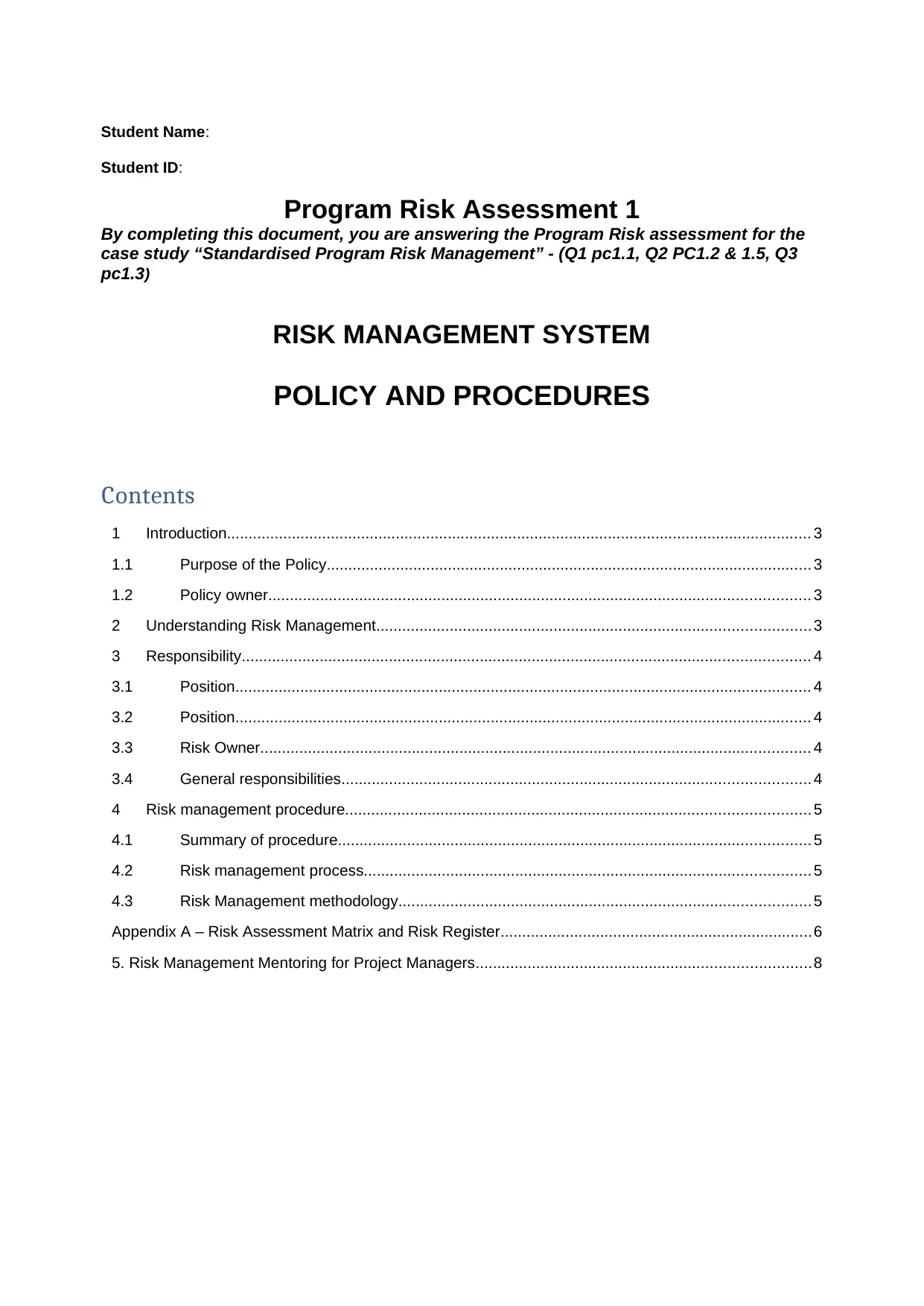
Student Name:
Student ID:
Program Risk Assessment 1
By completing this document, you are answering the Program Risk assessment for the
case study “Standardised Program Risk Management” - (Q1 pc1.1, Q2 PC1.2 & 1.5, Q3
pc1.3)
RISK MANAGEMENT SYSTEM
POLICY AND PROCEDURES
Contents
1 Introduction....................................................................................................................................... 3
1.1 Purpose of the Policy................................................................................................................ 3
1.2 Policy owner............................................................................................................................. 3
2 Understanding Risk Management.................................................................................................... 3
3 Responsibility................................................................................................................................... 4
3.1 Position..................................................................................................................................... 4
3.2 Position..................................................................................................................................... 4
3.3 Risk Owner............................................................................................................................... 4
3.4 General responsibilities............................................................................................................ 4
4 Risk management procedure........................................................................................................... 5
4.1 Summary of procedure............................................................................................................. 5
4.2 Risk management process....................................................................................................... 5
4.3 Risk Management methodology............................................................................................... 5
Appendix A – Risk Assessment Matrix and Risk Register........................................................................6
5. Risk Management Mentoring for Project Managers.............................................................................8
Student ID:
Program Risk Assessment 1
By completing this document, you are answering the Program Risk assessment for the
case study “Standardised Program Risk Management” - (Q1 pc1.1, Q2 PC1.2 & 1.5, Q3
pc1.3)
RISK MANAGEMENT SYSTEM
POLICY AND PROCEDURES
Contents
1 Introduction....................................................................................................................................... 3
1.1 Purpose of the Policy................................................................................................................ 3
1.2 Policy owner............................................................................................................................. 3
2 Understanding Risk Management.................................................................................................... 3
3 Responsibility................................................................................................................................... 4
3.1 Position..................................................................................................................................... 4
3.2 Position..................................................................................................................................... 4
3.3 Risk Owner............................................................................................................................... 4
3.4 General responsibilities............................................................................................................ 4
4 Risk management procedure........................................................................................................... 5
4.1 Summary of procedure............................................................................................................. 5
4.2 Risk management process....................................................................................................... 5
4.3 Risk Management methodology............................................................................................... 5
Appendix A – Risk Assessment Matrix and Risk Register........................................................................6
5. Risk Management Mentoring for Project Managers.............................................................................8
Paraphrase This Document
Need a fresh take? Get an instant paraphrase of this document with our AI Paraphraser
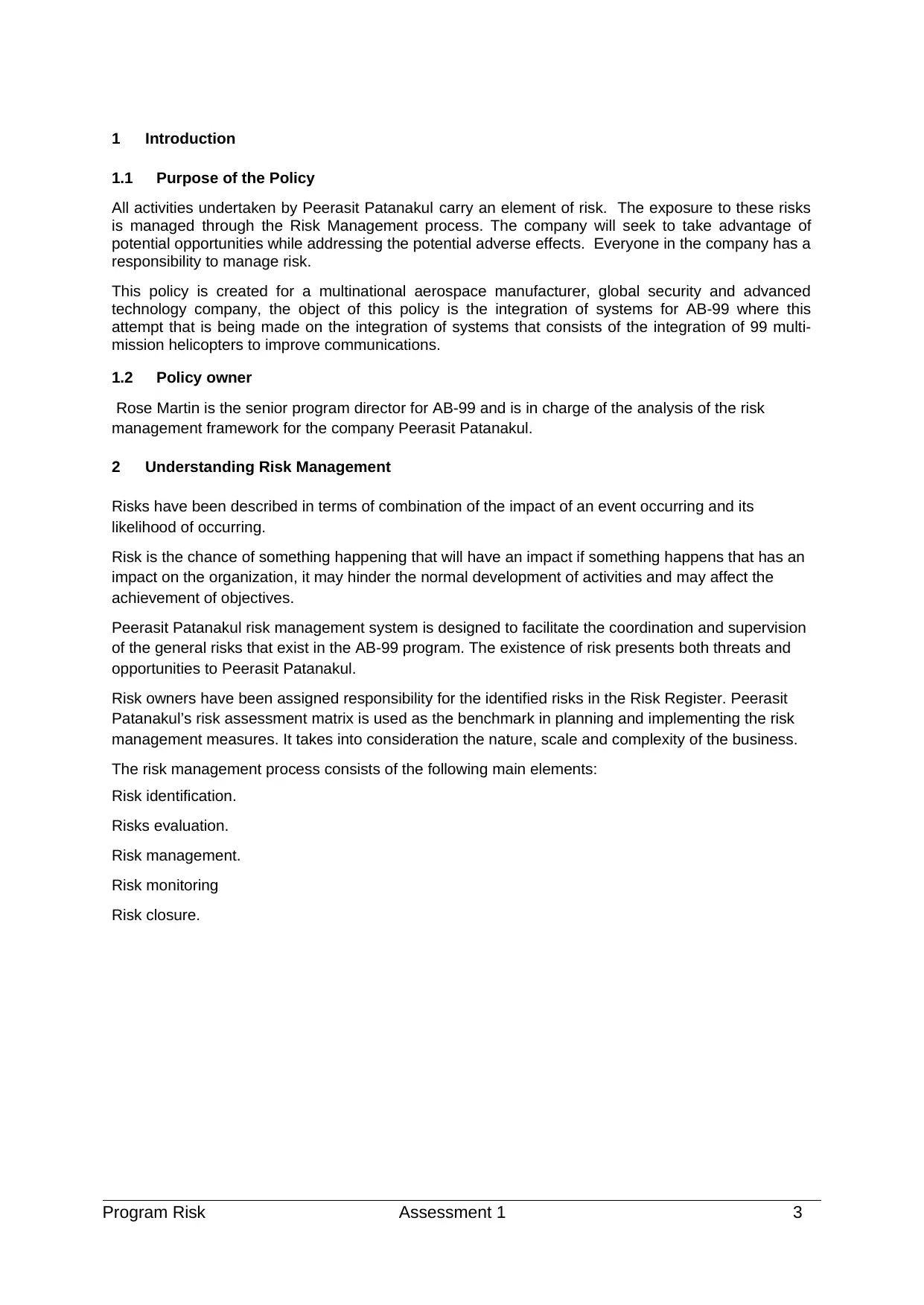
1 Introduction
1.1 Purpose of the Policy
All activities undertaken by Peerasit Patanakul carry an element of risk. The exposure to these risks
is managed through the Risk Management process. The company will seek to take advantage of
potential opportunities while addressing the potential adverse effects. Everyone in the company has a
responsibility to manage risk.
This policy is created for a multinational aerospace manufacturer, global security and advanced
technology company, the object of this policy is the integration of systems for AB-99 where this
attempt that is being made on the integration of systems that consists of the integration of 99 multi-
mission helicopters to improve communications.
1.2 Policy owner
Rose Martin is the senior program director for AB-99 and is in charge of the analysis of the risk
management framework for the company Peerasit Patanakul.
2 Understanding Risk Management
Risks have been described in terms of combination of the impact of an event occurring and its
likelihood of occurring.
Risk is the chance of something happening that will have an impact if something happens that has an
impact on the organization, it may hinder the normal development of activities and may affect the
achievement of objectives.
Peerasit Patanakul risk management system is designed to facilitate the coordination and supervision
of the general risks that exist in the AB-99 program. The existence of risk presents both threats and
opportunities to Peerasit Patanakul.
Risk owners have been assigned responsibility for the identified risks in the Risk Register. Peerasit
Patanakul’s risk assessment matrix is used as the benchmark in planning and implementing the risk
management measures. It takes into consideration the nature, scale and complexity of the business.
The risk management process consists of the following main elements:
Risk identification.
Risks evaluation.
Risk management.
Risk monitoring
Risk closure.
Program Risk Assessment 1 3
1.1 Purpose of the Policy
All activities undertaken by Peerasit Patanakul carry an element of risk. The exposure to these risks
is managed through the Risk Management process. The company will seek to take advantage of
potential opportunities while addressing the potential adverse effects. Everyone in the company has a
responsibility to manage risk.
This policy is created for a multinational aerospace manufacturer, global security and advanced
technology company, the object of this policy is the integration of systems for AB-99 where this
attempt that is being made on the integration of systems that consists of the integration of 99 multi-
mission helicopters to improve communications.
1.2 Policy owner
Rose Martin is the senior program director for AB-99 and is in charge of the analysis of the risk
management framework for the company Peerasit Patanakul.
2 Understanding Risk Management
Risks have been described in terms of combination of the impact of an event occurring and its
likelihood of occurring.
Risk is the chance of something happening that will have an impact if something happens that has an
impact on the organization, it may hinder the normal development of activities and may affect the
achievement of objectives.
Peerasit Patanakul risk management system is designed to facilitate the coordination and supervision
of the general risks that exist in the AB-99 program. The existence of risk presents both threats and
opportunities to Peerasit Patanakul.
Risk owners have been assigned responsibility for the identified risks in the Risk Register. Peerasit
Patanakul’s risk assessment matrix is used as the benchmark in planning and implementing the risk
management measures. It takes into consideration the nature, scale and complexity of the business.
The risk management process consists of the following main elements:
Risk identification.
Risks evaluation.
Risk management.
Risk monitoring
Risk closure.
Program Risk Assessment 1 3
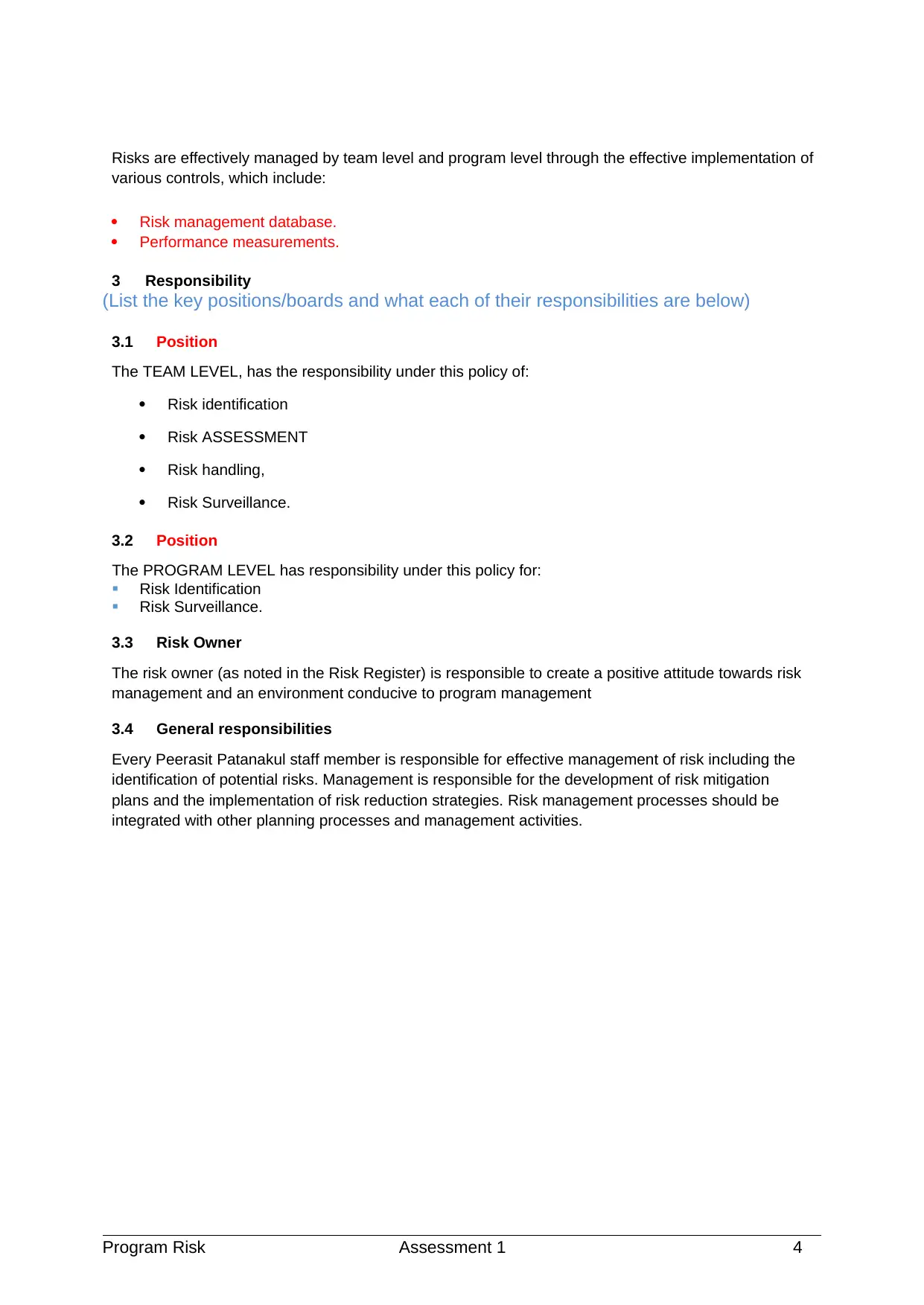
Risks are effectively managed by team level and program level through the effective implementation of
various controls, which include:
Risk management database.
Performance measurements.
3 Responsibility
(List the key positions/boards and what each of their responsibilities are below)
3.1 Position
The TEAM LEVEL, has the responsibility under this policy of:
Risk identification
Risk ASSESSMENT
Risk handling,
Risk Surveillance.
3.2 Position
The PROGRAM LEVEL has responsibility under this policy for:
Risk Identification
Risk Surveillance.
3.3 Risk Owner
The risk owner (as noted in the Risk Register) is responsible to create a positive attitude towards risk
management and an environment conducive to program management
3.4 General responsibilities
Every Peerasit Patanakul staff member is responsible for effective management of risk including the
identification of potential risks. Management is responsible for the development of risk mitigation
plans and the implementation of risk reduction strategies. Risk management processes should be
integrated with other planning processes and management activities.
Program Risk Assessment 1 4
various controls, which include:
Risk management database.
Performance measurements.
3 Responsibility
(List the key positions/boards and what each of their responsibilities are below)
3.1 Position
The TEAM LEVEL, has the responsibility under this policy of:
Risk identification
Risk ASSESSMENT
Risk handling,
Risk Surveillance.
3.2 Position
The PROGRAM LEVEL has responsibility under this policy for:
Risk Identification
Risk Surveillance.
3.3 Risk Owner
The risk owner (as noted in the Risk Register) is responsible to create a positive attitude towards risk
management and an environment conducive to program management
3.4 General responsibilities
Every Peerasit Patanakul staff member is responsible for effective management of risk including the
identification of potential risks. Management is responsible for the development of risk mitigation
plans and the implementation of risk reduction strategies. Risk management processes should be
integrated with other planning processes and management activities.
Program Risk Assessment 1 4
⊘ This is a preview!⊘
Do you want full access?
Subscribe today to unlock all pages.

Trusted by 1+ million students worldwide
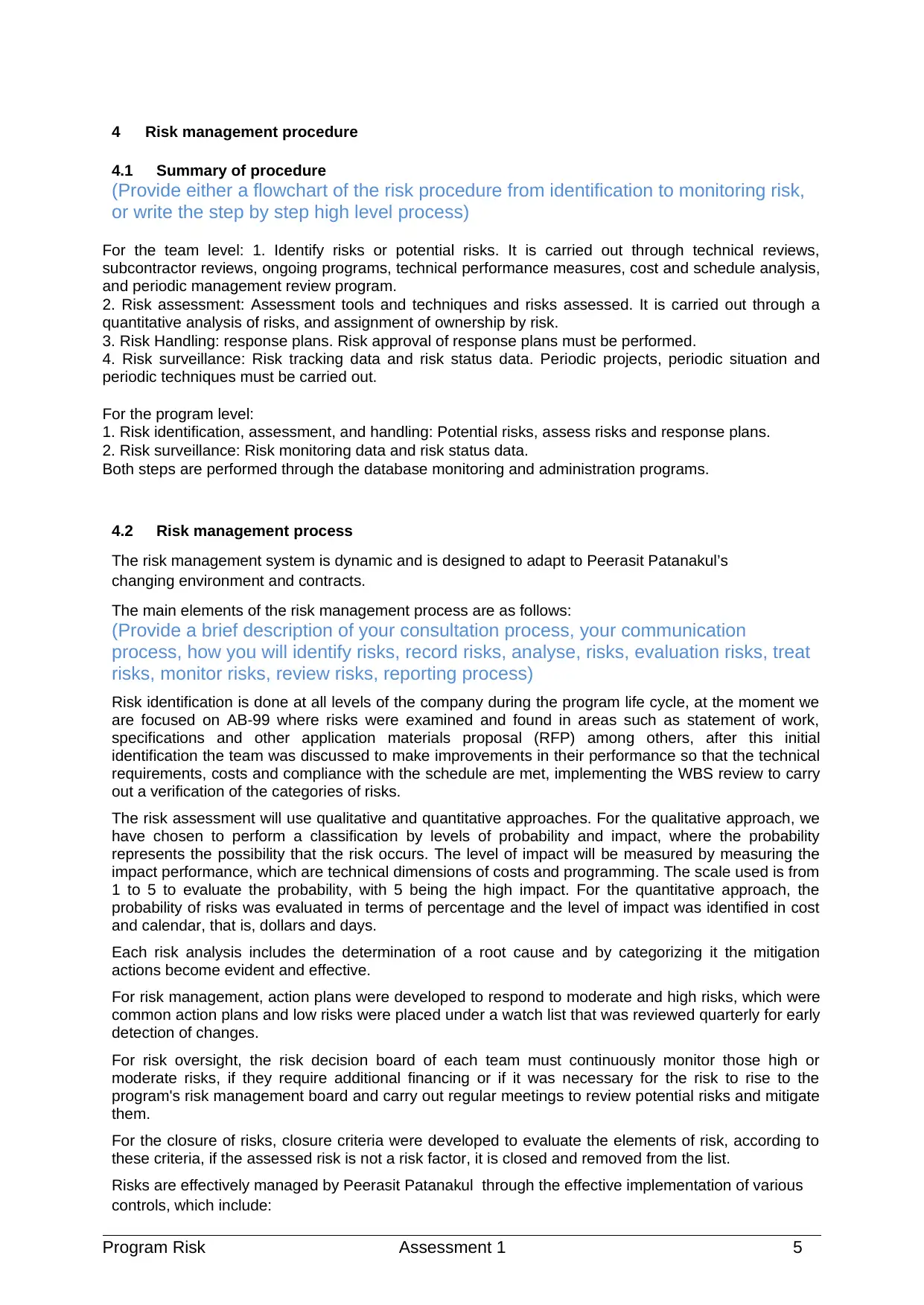
4 Risk management procedure
4.1 Summary of procedure
(Provide either a flowchart of the risk procedure from identification to monitoring risk,
or write the step by step high level process)
For the team level: 1. Identify risks or potential risks. It is carried out through technical reviews,
subcontractor reviews, ongoing programs, technical performance measures, cost and schedule analysis,
and periodic management review program.
2. Risk assessment: Assessment tools and techniques and risks assessed. It is carried out through a
quantitative analysis of risks, and assignment of ownership by risk.
3. Risk Handling: response plans. Risk approval of response plans must be performed.
4. Risk surveillance: Risk tracking data and risk status data. Periodic projects, periodic situation and
periodic techniques must be carried out.
For the program level:
1. Risk identification, assessment, and handling: Potential risks, assess risks and response plans.
2. Risk surveillance: Risk monitoring data and risk status data.
Both steps are performed through the database monitoring and administration programs.
4.2 Risk management process
The risk management system is dynamic and is designed to adapt to Peerasit Patanakul’s
changing environment and contracts.
The main elements of the risk management process are as follows:
(Provide a brief description of your consultation process, your communication
process, how you will identify risks, record risks, analyse, risks, evaluation risks, treat
risks, monitor risks, review risks, reporting process)
Risk identification is done at all levels of the company during the program life cycle, at the moment we
are focused on AB-99 where risks were examined and found in areas such as statement of work,
specifications and other application materials proposal (RFP) among others, after this initial
identification the team was discussed to make improvements in their performance so that the technical
requirements, costs and compliance with the schedule are met, implementing the WBS review to carry
out a verification of the categories of risks.
The risk assessment will use qualitative and quantitative approaches. For the qualitative approach, we
have chosen to perform a classification by levels of probability and impact, where the probability
represents the possibility that the risk occurs. The level of impact will be measured by measuring the
impact performance, which are technical dimensions of costs and programming. The scale used is from
1 to 5 to evaluate the probability, with 5 being the high impact. For the quantitative approach, the
probability of risks was evaluated in terms of percentage and the level of impact was identified in cost
and calendar, that is, dollars and days.
Each risk analysis includes the determination of a root cause and by categorizing it the mitigation
actions become evident and effective.
For risk management, action plans were developed to respond to moderate and high risks, which were
common action plans and low risks were placed under a watch list that was reviewed quarterly for early
detection of changes.
For risk oversight, the risk decision board of each team must continuously monitor those high or
moderate risks, if they require additional financing or if it was necessary for the risk to rise to the
program's risk management board and carry out regular meetings to review potential risks and mitigate
them.
For the closure of risks, closure criteria were developed to evaluate the elements of risk, according to
these criteria, if the assessed risk is not a risk factor, it is closed and removed from the list.
Risks are effectively managed by Peerasit Patanakul through the effective implementation of various
controls, which include:
Program Risk Assessment 1 5
4.1 Summary of procedure
(Provide either a flowchart of the risk procedure from identification to monitoring risk,
or write the step by step high level process)
For the team level: 1. Identify risks or potential risks. It is carried out through technical reviews,
subcontractor reviews, ongoing programs, technical performance measures, cost and schedule analysis,
and periodic management review program.
2. Risk assessment: Assessment tools and techniques and risks assessed. It is carried out through a
quantitative analysis of risks, and assignment of ownership by risk.
3. Risk Handling: response plans. Risk approval of response plans must be performed.
4. Risk surveillance: Risk tracking data and risk status data. Periodic projects, periodic situation and
periodic techniques must be carried out.
For the program level:
1. Risk identification, assessment, and handling: Potential risks, assess risks and response plans.
2. Risk surveillance: Risk monitoring data and risk status data.
Both steps are performed through the database monitoring and administration programs.
4.2 Risk management process
The risk management system is dynamic and is designed to adapt to Peerasit Patanakul’s
changing environment and contracts.
The main elements of the risk management process are as follows:
(Provide a brief description of your consultation process, your communication
process, how you will identify risks, record risks, analyse, risks, evaluation risks, treat
risks, monitor risks, review risks, reporting process)
Risk identification is done at all levels of the company during the program life cycle, at the moment we
are focused on AB-99 where risks were examined and found in areas such as statement of work,
specifications and other application materials proposal (RFP) among others, after this initial
identification the team was discussed to make improvements in their performance so that the technical
requirements, costs and compliance with the schedule are met, implementing the WBS review to carry
out a verification of the categories of risks.
The risk assessment will use qualitative and quantitative approaches. For the qualitative approach, we
have chosen to perform a classification by levels of probability and impact, where the probability
represents the possibility that the risk occurs. The level of impact will be measured by measuring the
impact performance, which are technical dimensions of costs and programming. The scale used is from
1 to 5 to evaluate the probability, with 5 being the high impact. For the quantitative approach, the
probability of risks was evaluated in terms of percentage and the level of impact was identified in cost
and calendar, that is, dollars and days.
Each risk analysis includes the determination of a root cause and by categorizing it the mitigation
actions become evident and effective.
For risk management, action plans were developed to respond to moderate and high risks, which were
common action plans and low risks were placed under a watch list that was reviewed quarterly for early
detection of changes.
For risk oversight, the risk decision board of each team must continuously monitor those high or
moderate risks, if they require additional financing or if it was necessary for the risk to rise to the
program's risk management board and carry out regular meetings to review potential risks and mitigate
them.
For the closure of risks, closure criteria were developed to evaluate the elements of risk, according to
these criteria, if the assessed risk is not a risk factor, it is closed and removed from the list.
Risks are effectively managed by Peerasit Patanakul through the effective implementation of various
controls, which include:
Program Risk Assessment 1 5
Paraphrase This Document
Need a fresh take? Get an instant paraphrase of this document with our AI Paraphraser

Risk Management database
Performance measurements.
4.3 Risk Management methodology
The methodology adopted by ABC for managing and treating its risks can be defined as follows:
(Explain the methodology you will use Include:
How will you identify risks
Will you use risk categories and if so what are they?
Describe you will assign likelihood ratings
Describe how you will assign impact ratings
Describe how you will assign the overall risk rating per risk
Describe how you will then prioritise all of the risks
How will you develop mitigations strategies?
Who will approve the strategies?
What is the process for monitoring and review risks)
Risks will be identified at all levels and in the program life cycle are identified through contract
requirements, technical requirements, cost objectives, and schedule goals.
The risk categories are reviewed using the WBS against the internal risk taxonomy. The
risks were classified by level of probability and impact, using a scale from 1 to 5 and the
probability of risks is evaluated in terms of percentage and the level of impact. It will be
taken in terms of dollars, that is, costs and days, that is, the schedule that must be
followed.
For the level of impact, adverse trends are measured and predicted in the impact or risk
performance measurement parameters that are designed in technical dimensions, costs
and programming.
The risk matrix assists in risk prioritization and group review and discussion of risk and
mitigation schemes step by step, risk analysis also includes a determination of a root
cause, and in doing so, mitigation actions they become evident and effective.
The mitigation strategies were carried out through action plans to respond to moderate
and high risks where the avoidance, mitigation and use of contingencies were through
common action plans where low risks are kept on a watch list that are reviewed
quarterly to detect changes and remove them when not applicable.
The strategies are approved at the team level by the risk management board where
elements of high or moderate risk are continuously monitored, and risk elevations are
also made to the program's risk management board.
Risks are reviewed by continuous monitoring of items of high or moderate risk, and
when it changes from moderate or high or low it should be put on a watch and
monitoring list to detect changes, or if they need additional funding from the
management reserve, the program's risk management board meets periodically to
review and discuss potential new risks and manage existing risk mitigation efforts.
Program Risk Assessment 1 6
Performance measurements.
4.3 Risk Management methodology
The methodology adopted by ABC for managing and treating its risks can be defined as follows:
(Explain the methodology you will use Include:
How will you identify risks
Will you use risk categories and if so what are they?
Describe you will assign likelihood ratings
Describe how you will assign impact ratings
Describe how you will assign the overall risk rating per risk
Describe how you will then prioritise all of the risks
How will you develop mitigations strategies?
Who will approve the strategies?
What is the process for monitoring and review risks)
Risks will be identified at all levels and in the program life cycle are identified through contract
requirements, technical requirements, cost objectives, and schedule goals.
The risk categories are reviewed using the WBS against the internal risk taxonomy. The
risks were classified by level of probability and impact, using a scale from 1 to 5 and the
probability of risks is evaluated in terms of percentage and the level of impact. It will be
taken in terms of dollars, that is, costs and days, that is, the schedule that must be
followed.
For the level of impact, adverse trends are measured and predicted in the impact or risk
performance measurement parameters that are designed in technical dimensions, costs
and programming.
The risk matrix assists in risk prioritization and group review and discussion of risk and
mitigation schemes step by step, risk analysis also includes a determination of a root
cause, and in doing so, mitigation actions they become evident and effective.
The mitigation strategies were carried out through action plans to respond to moderate
and high risks where the avoidance, mitigation and use of contingencies were through
common action plans where low risks are kept on a watch list that are reviewed
quarterly to detect changes and remove them when not applicable.
The strategies are approved at the team level by the risk management board where
elements of high or moderate risk are continuously monitored, and risk elevations are
also made to the program's risk management board.
Risks are reviewed by continuous monitoring of items of high or moderate risk, and
when it changes from moderate or high or low it should be put on a watch and
monitoring list to detect changes, or if they need additional funding from the
management reserve, the program's risk management board meets periodically to
review and discuss potential new risks and manage existing risk mitigation efforts.
Program Risk Assessment 1 6
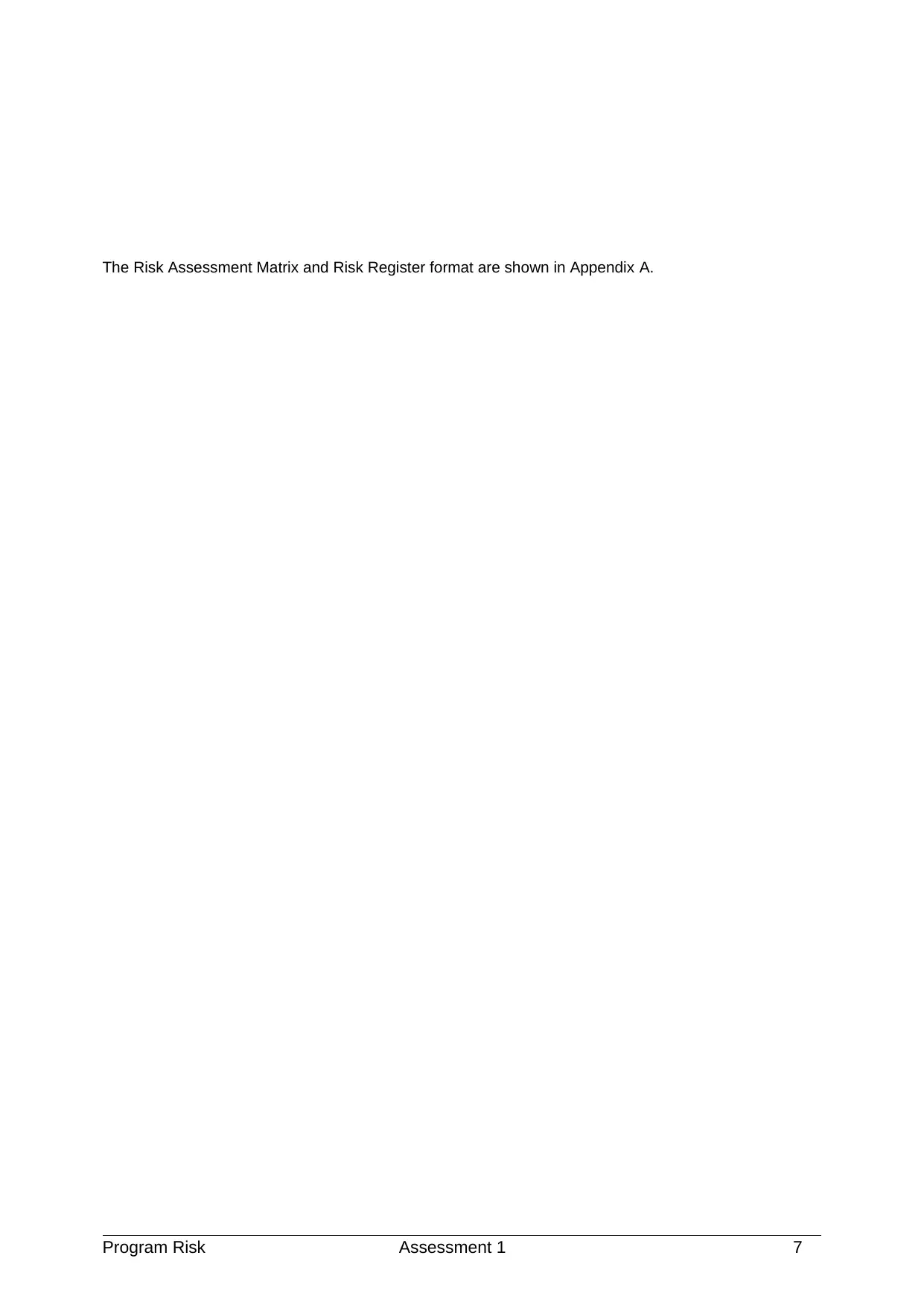
The Risk Assessment Matrix and Risk Register format are shown in Appendix A.
Program Risk Assessment 1 7
Program Risk Assessment 1 7
⊘ This is a preview!⊘
Do you want full access?
Subscribe today to unlock all pages.

Trusted by 1+ million students worldwide
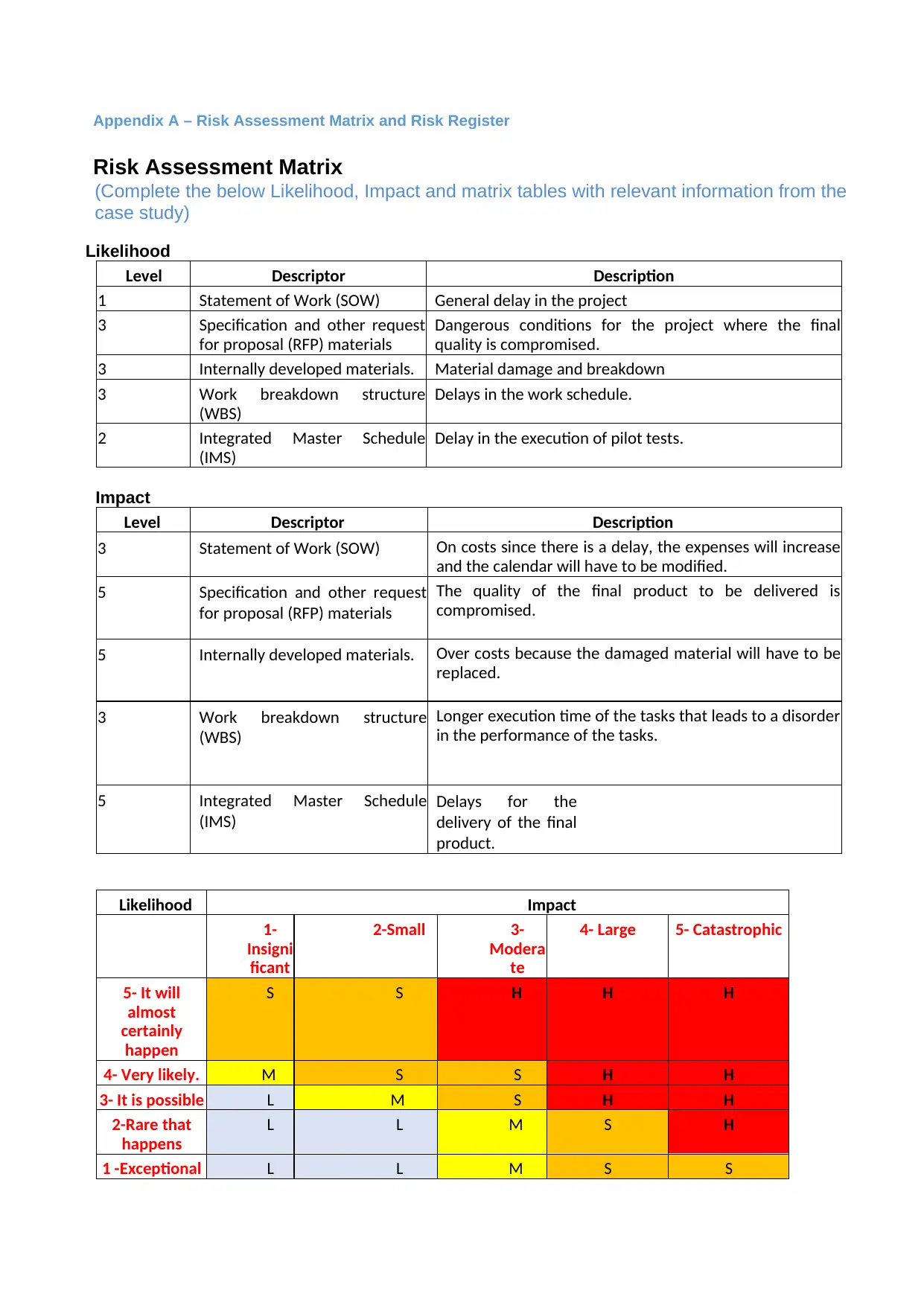
Appendix A – Risk Assessment Matrix and Risk Register
Risk Assessment Matrix
(Complete the below Likelihood, Impact and matrix tables with relevant information from the
case study)
Likelihood
Level Descriptor Description
1 Statement of Work (SOW) General delay in the project
3 Specification and other request
for proposal (RFP) materials
Dangerous conditions for the project where the final
quality is compromised.
3 Internally developed materials. Material damage and breakdown
3 Work breakdown structure
(WBS)
Delays in the work schedule.
2 Integrated Master Schedule
(IMS)
Delay in the execution of pilot tests.
Impact
Level Descriptor Description
3 Statement of Work (SOW) On costs since there is a delay, the expenses will increase
and the calendar will have to be modified.
5 Specification and other request
for proposal (RFP) materials
The quality of the final product to be delivered is
compromised.
5 Internally developed materials. Over costs because the damaged material will have to be
replaced.
3 Work breakdown structure
(WBS)
Longer execution time of the tasks that leads to a disorder
in the performance of the tasks.
5 Integrated Master Schedule
(IMS)
Delays for the
delivery of the final
product.
Likelihood Impact
1-
Insigni
ficant
2-Small 3-
Modera
te
4- Large 5- Catastrophic
5- It will
almost
certainly
happen
S S H H H
4- Very likely. M S S H H
3- It is possible L M S H H
2-Rare that
happens
L L M S H
1 -Exceptional L L M S S
Risk Assessment Matrix
(Complete the below Likelihood, Impact and matrix tables with relevant information from the
case study)
Likelihood
Level Descriptor Description
1 Statement of Work (SOW) General delay in the project
3 Specification and other request
for proposal (RFP) materials
Dangerous conditions for the project where the final
quality is compromised.
3 Internally developed materials. Material damage and breakdown
3 Work breakdown structure
(WBS)
Delays in the work schedule.
2 Integrated Master Schedule
(IMS)
Delay in the execution of pilot tests.
Impact
Level Descriptor Description
3 Statement of Work (SOW) On costs since there is a delay, the expenses will increase
and the calendar will have to be modified.
5 Specification and other request
for proposal (RFP) materials
The quality of the final product to be delivered is
compromised.
5 Internally developed materials. Over costs because the damaged material will have to be
replaced.
3 Work breakdown structure
(WBS)
Longer execution time of the tasks that leads to a disorder
in the performance of the tasks.
5 Integrated Master Schedule
(IMS)
Delays for the
delivery of the final
product.
Likelihood Impact
1-
Insigni
ficant
2-Small 3-
Modera
te
4- Large 5- Catastrophic
5- It will
almost
certainly
happen
S S H H H
4- Very likely. M S S H H
3- It is possible L M S H H
2-Rare that
happens
L L M S H
1 -Exceptional L L M S S
Paraphrase This Document
Need a fresh take? Get an instant paraphrase of this document with our AI Paraphraser

Legend:
H High risk; detailed research and management planning required at senior levels
S Significant risk; senior management attention needed
M Moderate risk; management responsibility must be specified
L Low risk; manage by routine procedures
H High risk; detailed research and management planning required at senior levels
S Significant risk; senior management attention needed
M Moderate risk; management responsibility must be specified
L Low risk; manage by routine procedures
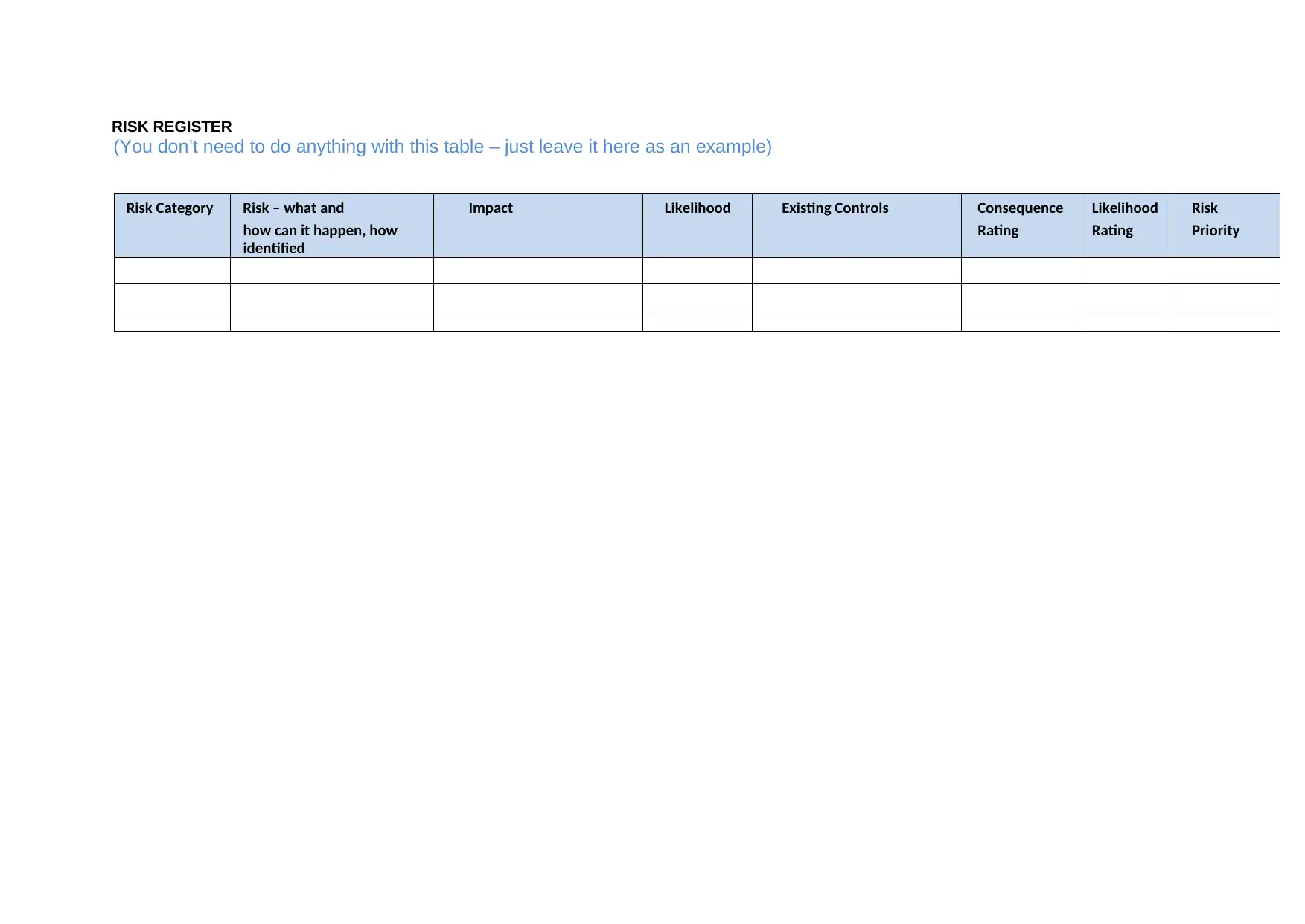
RISK REGISTER
(You don’t need to do anything with this table – just leave it here as an example)
Risk Category Risk – what and
how can it happen, how
identified
Impact Likelihood Existing Controls Consequence
Rating
Likelihood
Rating
Risk
Priority
(You don’t need to do anything with this table – just leave it here as an example)
Risk Category Risk – what and
how can it happen, how
identified
Impact Likelihood Existing Controls Consequence
Rating
Likelihood
Rating
Risk
Priority
⊘ This is a preview!⊘
Do you want full access?
Subscribe today to unlock all pages.

Trusted by 1+ million students worldwide

5. Risk Management Mentoring for Project Managers
(As program manager, explain how you will mentor two new project managers that report to
you in the AB-99 program of work. How will you assist them to analyse, evaluate and come
up with risk action plans?)
Initially, their responsibilities will be established and who will be the team that will accompany
them for the execution of said project, they must establish the risk management project
planning that must be identified from the beginning of the project. During planning, the
project manager must identify the possible risks that may affect the project.
Another suggestion is that the changes that are generated in the project must be made by
the project managers and that you cannot do it alone since you must have the help of the
rest of the team to have various points of view, planning and meetings of the scope and
schedule tasks to adequately monitor all risks.
Finally, I would suggest the use of a tool for risk planning of a project integrated with the
general planning, since changes in risks imply changes in costs, resources, personnel and
tasks and these aspects must be kept integrated and updated depending on risk
management. And the comprehensive management tool is a good investment to facilitate the
integration and maintenance of these plans.
(As program manager, explain how you will mentor two new project managers that report to
you in the AB-99 program of work. How will you assist them to analyse, evaluate and come
up with risk action plans?)
Initially, their responsibilities will be established and who will be the team that will accompany
them for the execution of said project, they must establish the risk management project
planning that must be identified from the beginning of the project. During planning, the
project manager must identify the possible risks that may affect the project.
Another suggestion is that the changes that are generated in the project must be made by
the project managers and that you cannot do it alone since you must have the help of the
rest of the team to have various points of view, planning and meetings of the scope and
schedule tasks to adequately monitor all risks.
Finally, I would suggest the use of a tool for risk planning of a project integrated with the
general planning, since changes in risks imply changes in costs, resources, personnel and
tasks and these aspects must be kept integrated and updated depending on risk
management. And the comprehensive management tool is a good investment to facilitate the
integration and maintenance of these plans.
1 out of 10
Related Documents
Your All-in-One AI-Powered Toolkit for Academic Success.
+13062052269
info@desklib.com
Available 24*7 on WhatsApp / Email
![[object Object]](/_next/static/media/star-bottom.7253800d.svg)
Unlock your academic potential
Copyright © 2020–2025 A2Z Services. All Rights Reserved. Developed and managed by ZUCOL.




